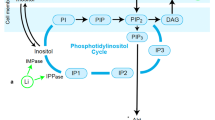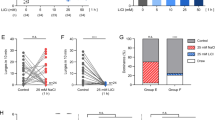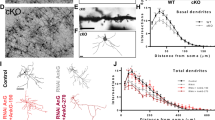Abstract
Bipolar disorder (BP) is a debilitating psychiatric disorder, affecting ∼2% of the worldwide population, for which the etiological basis, pathogenesis, and neurocircuitry remain poorly understood. Individuals with BP suffer from recurrent episodes of mania and depression, which are commonly treated with the mood stabilizer lithium. However, nearly half of BP patients do not respond adequately to lithium therapy and the clinically relevant mechanisms of lithium for mood stabilization remain elusive. Here, we modeled lithium responsiveness using cellular assays of glycogen synthase kinase 3 (GSK-3) signaling and mood-related behavioral assays in inbred strains of mice that differ in their response to lithium. We found that activating AKT through phosphosrylation of a key regulatory site (Thr308) was associated with lithium response—activation of signaling pathways downstream of GSK-3 in cells and attenuation of mood-related behaviors in mice—and this response was attenuated by selective and direct inhibition of AKT kinase activity. Conversely, the expression of constitutively active AKT1 in both the cellular and behavioral assays conferred lithium sensitivity. In contrast, selective and direct GSK-3 inhibition by the ATP-competitive inhibitor CHIR99021 bypassed the requirement for AKT activation and modulated behavior in both lithium-responsive and non-responsive mouse strains. These results distinguish the mechanism of action of lithium from direct GSK-3 inhibition both in vivo and in vitro, and highlight the therapeutic potential for selective GSK-3 inhibitors in BP treatment.
Similar content being viewed by others
Log in or create a free account to read this content
Gain free access to this article, as well as selected content from this journal and more on nature.com
or
References
Arban R, Maraia G, Brackenborough K, Winyard L, Wilson A, Gerrard P et al (2005). Evaluation of the effects of lamotrigine, valproate and carbamazepine in a rodent model of mania. Behav Brain Res 158: 123–132.
Bain J, Plater L, Elliott M, Shpiro N, Hastie CJ, McLauchlan H et al (2007). The selectivity of protein kinase inhibitors: a further update. Biochem J 408: 297–315.
Beaulieu JM, Gainetdinov RR, Caron MG (2007a). The Akt-GSK-3 signaling cascade in the actions of dopamine. Trends Pharmacol Sci 28: 166–172.
Beaulieu JM, Gainetdinov RR, Caron MG (2009). Akt/GSK3 signaling in the action of psychotropic drugs. Annu Rev Pharmacol Toxicol 49: 327–347.
Beaulieu JM, Marion S, Rodriguiz RM, Medvedev IO, Sotnikova TD, Ghisi V et al (2008). A beta-arrestin 2 signaling complex mediates lithium action on behavior. Cell 132: 125–136.
Beaulieu JM, Sotnikova TD, Marion S, Lefkowitz RJ, Gainetdinov RR, Caron MG (2005). An Akt/beta-arrestin 2/PP2A signaling complex mediates dopaminergic neurotransmission and behavior. Cell 122: 261–273.
Beaulieu JM, Sotnikova TD, Yao WD, Kockeritz L, Woodgett JR, Gainetdinov RR et al (2004). Lithium antagonizes dopamine-dependent behaviors mediated by an AKT/glycogen synthase kinase 3 signaling cascade. Proc Natl Acad Sci USA 101: 5099–5104.
Beaulieu JM, Tirotta E, Sotnikova TD, Masri B, Salahpour A, Gainetdinov RR et al (2007b). Regulation of Akt signaling by D2 and D3 dopamine receptors in vivo. J Neurosci 27: 881–885.
Berridge MJ, Irvine RF (1989). Inositol phosphates and cell signalling. Nature 341: 197–205.
Biechele TL, Moon RT (2008). Assaying beta-catenin/TCF transcription with beta-catenin/TCF transcription-based reporter constructs. Methods Mol Bio 468: 99–110.
Biechele TL, Adams AM, Moon RT (2009). Transcription-based reporters of Wnt/beta catnein signaling. Cold Spring Harb Protoc 2009: pdb.prot5223.
Böer U, Cierny I, Krause D, Heinrich A, Lin H, Mayr G et al (2008). Chronic lithium salt treatment reduces CRE/CREB-directed gene transcription and reverses its upregulation by chronic psychosocial stress in transgenic reporter gene mice. Neuropsychopharmacology 33: 2407–2415.
Bowden CL (2000). Efficacy of lithium in mania and maintenance therapy of bipolar disorder. J Clin Psychiatry 61 (Suppl 9): 35–40.
Brami-Cherrier K, Valjent E, Garcia M, Pages C, Hipskind RA, Caboche J (2002). Dopamine induces a PI3-kinase-independent activation of Akt in striatal neurons: a new route to cAMP response element-binding protein phosphorylation. J Neurosci 22: 8911–8921.
Cade JF (1949). Lithium salts in the treatment of psychotic excitement. Med J Aust 2: 349–352.
Chalecka-Franaszek E, Chuang DM (1999). Lithium activates the serine/threonine kinase Akt-1 and suppresses glutamate-induced inhibition of Akt-1 activity in neurons. Proc Natl Acad Sci USA 96: 8745–8750.
De Sarno P, Li X, Jope RS (2002). Regulation of Akt and glycogen synthase kinase-3 beta phosphorylation by sodium valproate and lithium. Neuropharmacology 43: 1158–1164.
Dencker D, Dias R, Pedersen ML, Husum H (2008). Effect of the new antiepileptic drug retigabine in a rodent model of mania. Epilepsy Behav 12: 49–53.
Emamian ES, Hall D, Birnbaum MJ, Karayiorgou M, Gogos JA (2004). Convergent evidence for impaired AKT1-GSK3beta signaling in schizophrenia. Nat Genet 36: 131–137.
Fabian MA, Biggs III WH, Treiber DK, Atteridge CE, Azimioara MD, Benedetti MG et al (2005). A small molecule-kinase interaction map for clinical kinase inhibitors. Nat Biotechnol 23: 329–336.
Geddes JR, Goodwin GM, Rendell J, Azorin JM, Cipriani A, Ostacher MJ et al (2010). Lithium plus valproate combination therapy versus monotherapy for relapse prevention in bipolar I disorder (BALANCE): a randomised open-label trial. Lancet 375: 385–395.
Ghisi V, Ramsey AJ, Masri B, Gainetdinov RR, Caron MG, Salahpour A (2009). Reduced D2-mediated signaling activity and trans-synaptic upregulation of D1 and D2 dopamine receptors in mice overexpressing the dopamine transporter. Cell Signal 21: 87–94.
Gould TD, Einat H, Bhat R, Manji HK (2004). AR-A014418, a selective GSK-3 inhibitor, produces antidepressant-like effects in the forced swim test. Int J Neuropsychopharmacol 7: 387–390.
Gould TD, Picchini AM, Einat H, Manji HK (2006). Targeting glycogen synthase kinase-3 in the CNS: implications for the development of new treatments for mood disorders. Curr Drug Targets 7: 1399–1409.
Gould TD, O’Donnell KC, Picchini AM, Manji HK (2007). Strain differences in lithium attenuation of d-amphetamine-induced hyperlocomotion: a mouse model for the genetics of clinical response to lithium. Neuropsychopharmacology 32: 1321–1333.
Hedgepeth CM, Conrad LJ, Zhang J, Huang HC, Lee VM, Klein PS (1997). Activation of the Wnt signaling pathway: a molecular mechanism for lithium action. Dev Biol 185: 82–91.
Kaidanovich-Beilin O, Lipina TV, Takao K, van Eede M, Hattori S, Laliberte C et al (2009). Abnormalities in brain structure and behavior in GSK-3alpha mutant mice. Mol Brain 2: 35.
Kim WY, Kim S, Kim JH (2008). Chronic microinjection of valproic acid into the nucleus accumbens attenuates amphetamine-induced locomotor activity. Neurosci Lett 432: 54–57.
Klein PS, Melton DA (1996). A molecular mechanism for the effect of lithium on development. Proc Natl Acad Sci USA 93: 8455–8459.
Krishnan V, Han MH, Mazei-Robison M, Iniguez SD, Ables JL, Vialou V et al (2008). AKT signaling within the ventral tegmental area regulates cellular and behavioral responses to stressful stimuli. Biol Psychiatry 64: 691–700.
Lai WS, Xu B, Westphal KG, Paterlini M, Olivier B, Pavlidis P et al (2006). Akt1 deficiency affects neuronal morphology and predisposes to abnormalities in prefrontal cortex functioning. Proc Natl Acad Sci USA 103: 16906–16911.
Le Roy V, Delmas Y, Verdoux H (2009). Chronic renal complications induced by lithium. Encephale 35: 605–610.
Leucht S, Kissling W, McGrath J (2004). Lithium for schizophrenia revisited: a systematic review and meta-analysis of randomized controlled trials. J Clin Psychiatry 65: 177–186.
Mavrikaki M, Nomikos GG, Panagis G (2010). Efficacy of the atypical antipsychotic aripiprazole in d-amphetamine-based preclinical models of mania. Int J Neuropsychopharmacol 13: 541–548.
McGinty JF, Shi XD, Schwendt M, Saylor A, Toda S (2008). Regulation of psychostimulant-induced signaling and gene expression in the striatum. J Neurochem 104: 1440–1449.
O’Brien WT, Harper AD, Jove F, Woodgett JR, Maretto S, Piccolo S et al (2004). Glycogen synthase kinase-3beta haploinsufficiency mimics the behavioral and molecular effects of lithium. J Neurosci 24: 6791–6798.
O’Brien WT, Klein PS (2009). Validating GSK3 as an in vivo target of lithium action. Biochem Soc Trans 37: 1133–1138.
O’Donnell KC, Gould TD (2007). The behavioral actions of lithium in rodent models: leads to develop novel therapeutics. Neurosci Biobehav Rev 31: 932–962.
Perry W, Minassian A, Paulus MP, Young JW, Kincaid MJ, Ferguson EJ et al (2009). A reverse-translational study of dysfunctional exploration in psychiatric disorders: from mice to men. Arch Gen Psychiatry 66: 1072–1080.
Polter A, Beurel E, Yang S, Garner R, Song L, Miller CA et al (2010). Deficiency in the inhibitory serine-phosphorylation of glycogen synthase kinase-3 Increases sensitivity to mood disturbances. Neuropsychopharmacology 35: 1761–1774.
Prickaerts J, Moechars D, Cryns K, Lenaerts I, van Craenendonck H, Goris I et al (2006). Transgenic mice overexpressing glycogen synthase kinase 3beta: a putative model of hyperactivity and mania. J Neurosci 26: 9022–9029.
Ring DB, Johnson KW, Henriksen EJ, Nuss JM, Goff D, Kinnick TR et al (2003). Selective glycogen synthase kinase 3 inhibitors potentiate insulin activation of glucose transport and utilization in vitro and in vivo. Diabetes 52: 588–595.
Rothman RB, Baumann MH (2006). Balance between dopamine and serotonin release modulates behavioral effects of amphetamine-type drugs. Ann NY Acad Sci 1074: 245–260.
Tan HY, Nicodemus KK, Chen Q, Li Z, Brooke JK, Honea R et al (2008). Genetic variation in AKT1 is linked to dopamine-associated prefrontal cortical structure and function in humans. J Clin Invest 118: 2200–2208.
Thiselton DL, Vladimirov VI, Kuo PH, McClay J, Wormley B, Fanous A et al (2008). AKT1 is associated with schizophrenia across multiple symptom dimensions in the Irish study of high density schizophrenia families. Biol Psychiatry 63: 449–457.
Tondo L, Baldessarini RJ (2009). Long-term lithium treatment in the prevention of suicidal behavior in bipolar disorder patients. Epidemiol Psychiatry Soc 18: 179–183.
Vasdev N, Garcia A, Stableford WT, Young AB, Meyer JH, Houle S et al (2005). Synthesis and ex vivo evaluation of carbon-11 labelled N-(4-methoxybenzyl)-N′-(5-nitro-1,3-thiazol-2-yl)urea ([11C]AR-A014418): a radiolabelled glycogen synthase kinase-3beta specific inhibitor for PET studies. Bioorg Med Chem Lett 15: 5270–5273.
Yuan H, Mao J, Li L, Wu D (1999). Suppression of glycogen synthase kinase activity is not sufficient for leukemia enhancer factor-1 activation. J Biol Chem 274: 30419–30423.
Zhao Z, Robinson RG, Barnett SF, Defeo-Jones D, Jones RE, Hartman GD et al (2008). Development of potent, allosteric dual Akt1 and Akt2 inhibitors with improved physical properties and cell activity. Bioorg Med Chem Lett 18: 49–53.
Zhuang X, Oosting RS, Jones SR, Gainetdinov RR, Miller GW, Caron MG et al (2001). Hyperactivity and impaired response habituation in hyperdopaminergic mice. Proc Natl Acad Sci USA 98: 1982–1987.
Acknowledgements
We thank Drs Li-Huei Tsai, Daniel Fass, Jon Madison, Pamela Sklar, Melanie Leussis, and Roy Perlis for critical reading of the paper. We thank Dr Jennifer Moran for technical assistance with HT-22 cell genotype analysis. We thank Dr. Michael Moyer for assistance with the AKT inhibitor experiments. We thank Drs M Mazei-Robison and E Nestler for providing HSV-AKT1 constructs. This work was supported by grants from the National Institutes of Health (RL1GM084437 to EMS, administratively linked to RL1CA133834, RL1HG004671, and UL1RR024924; MH087442-01 to JP and SJH) and the Stanley Medical Research Institute (to EMS, SJH, TLP). RTM is an investigator of the HHMI.
Author information
Authors and Affiliations
Corresponding authors
Ethics declarations
Competing interests
The authors declare no conflict of interest.
Additional information
Supplementary Information accompanies the paper on the Neuropsychopharmacology website
Rights and permissions
About this article
Cite this article
Pan, J., Lewis, M., Ketterman, J. et al. AKT Kinase Activity Is Required for Lithium to Modulate Mood-Related Behaviors in Mice. Neuropsychopharmacol 36, 1397–1411 (2011). https://doi.org/10.1038/npp.2011.24
Received:
Revised:
Accepted:
Published:
Issue date:
DOI: https://doi.org/10.1038/npp.2011.24
Keywords
This article is cited by
-
Lithium rescues dendritic abnormalities in Ank3 deficiency models through the synergic effects of GSK3β and cyclic AMP signaling pathways
Neuropsychopharmacology (2023)
-
Mood and behavior regulation: interaction of lithium and dopaminergic system
Naunyn-Schmiedeberg's Archives of Pharmacology (2023)
-
Insulin signaling as a therapeutic mechanism of lithium in bipolar disorder
Translational Psychiatry (2022)
-
Advances toward precision medicine for bipolar disorder: mechanisms & molecules
Molecular Psychiatry (2021)
-
Small-molecule suppression of calpastatin degradation reduces neuropathology in models of Huntington’s disease
Nature Communications (2021)



